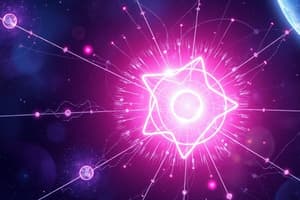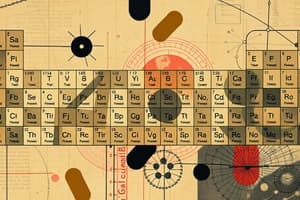Podcast
Questions and Answers
Which of the following best describes the properties of elements in a given period?
Which of the following best describes the properties of elements in a given period?
- Elements in the same period show a gradual trend in properties as the number of electrons increases within the same shell. (correct)
- Elements in the same period have identical chemical properties due to having the same number of valence electrons.
- Elements in the same period have the same melting and boiling points, primarily based on the total number of electrons they possess.
- Elements in the same period have drastically different electron configurations due to having different subshell occupancies.
What is a primary characteristic of transition metals related to their electronic configurations?
What is a primary characteristic of transition metals related to their electronic configurations?
- They have partially filled d orbitals, which influences their variable oxidation states and properties. (correct)
- They have completely filled d orbitals, which contributes to their unreactivity.
- They have completely empty d orbitals, which causes them to be highly electronegative.
- They have completely filled s and p orbitals, making them highly stable.
Which of the following is an example of a redox reaction involving zinc (Zn)?
Which of the following is an example of a redox reaction involving zinc (Zn)?
- The reaction of zinc with hydrochloric acid, which forms a precipitate.
- The reduction of zinc oxide ($ZnO$) to form zinc metal ($Zn$). (correct)
- The dissociation of zinc chloride in an aqueous solution.
- The decomposition of zinc hydroxide into zinc oxide and water.
How does the concept of alloying relate to the properties of metallic elements?
How does the concept of alloying relate to the properties of metallic elements?
Which of the following statements is true about the electrical conductivity of elements?
Which of the following statements is true about the electrical conductivity of elements?
Based on the information given, what is a characteristic of mercury (Hg) at room temperature?
Based on the information given, what is a characteristic of mercury (Hg) at room temperature?
What is the significance of the oxidation state of manganese (Mn)?
What is the significance of the oxidation state of manganese (Mn)?
Which statement best describes the filling of orbitals during the progression across a period?
Which statement best describes the filling of orbitals during the progression across a period?
Flashcards
Periods in Chemistry
Periods in Chemistry
Horizontal rows in the periodic table, showing trends in properties and electron configurations.
Electron Configurations
Electron Configurations
Arrangement of electrons in an atom's orbitals, related to an element's properties.
Oxidation States
Oxidation States
The charge of an atom in a compound, indicating gain or loss of electrons.
Zinc Oxidation Reaction
Zinc Oxidation Reaction
Signup and view all the flashcards
Properties of Elements
Properties of Elements
Signup and view all the flashcards
Transition Metals
Transition Metals
Signup and view all the flashcards
Melting and Boiling Points
Melting and Boiling Points
Signup and view all the flashcards
Electrical Conductivity
Electrical Conductivity
Signup and view all the flashcards
Study Notes
General Characteristics of Elements
- Elements in groups 4-7 exhibit periodic trends, with irregularities in their electron configuration
- Transition metals have varying properties, including different boiling and melting points.
- Some elements have high reactivity, while others are less so.
- Some elements are good conductors of heat and electricity.
Electron Configuration and Atomic Properties
- Electron configuration of certain elements, like Scandium (Sc) are given as an example in the notes
- Elements with similar valence electron configurations often present similar properties
- The valence shell gives insight into similar chemical behavior
- Valence electron configurations and resulting properties are critical for understanding chemical reactions and bonding
Oxidation States and Reactions
- Examples of oxidation (Zn + O2 --> ZnO) and reduction to demonstrate redox reactions are included
- Examples of oxidation and reduction, e.g., Zn and Cu, demonstrate different reactions and roles
- Reactions of elements with oxygen are important, such as Zn + O2 --> ZnO or oxidation of metals; ZnO has a reduced form
- The oxidation states of specific elements (e.g., Mn) are presented, along with their corresponding compounds and oxidation states.
Physical and Chemical Properties
- Different states of matter (solids, liquids, and gases) and properties like melting and boiling points can predict reactivity
- Elements may exist in different oxidation states, influencing the compound properties
- Some elements can form distinct compounds, demonstrating unique chemical properties, e.g. transition metals form various colored compounds
- Some elements, e.g., Mn, have high oxidation states
Coordination Complexes
- Transition metals have the potential to form coordination complexes with ligands
- Coordination complexes have distinct shapes and behaviors influenced by ligands.
General Trends
- Elements in 4-7 rows have characteristic electron configurations
- Many elements show varying degrees of reactivity, conductivity, and other properties
- Different elements display distinctive physical properties like states of matter and melting points
- The notes outline general trends in properties associated with element groups
- Many elements in those rows have varying properties.
Studying That Suits You
Use AI to generate personalized quizzes and flashcards to suit your learning preferences.




